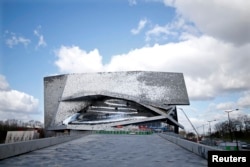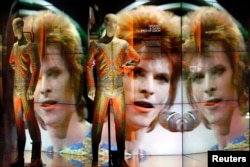The Parc de la Villette was packed on a recent afternoon. Women in West African boubous pushed baby carriages. A group of Chinese practiced dance moves. Young families and Frisbee players caught a few rays of spring sunshine.
Giant slaughterhouses stood here a century ago. Today, La Villette is an arts and science center located on edge of northeastern Paris. Ringed by highways and working-class neighborhoods, it’s a green oasis that bursts with every color of France’s ethnic rainbow.
Rap and world music stars perform at La Villette. But the park’s latest addition is playing a different tune, one that’s usually associated with the city’s more elegant neighborhoods.
The new Philharmonic complex opened its doors in January. Designed by star architect Jean Nouvel, it’s a massive, glittering showcase of cutting-edge sound and design that now houses the Paris symphony orchestra.
Perhaps more importantly, the Philharmonie de Paris is a bold, social experiment. The aim, says President Laurent Bayle, is to sell classical music to a younger, poorer and much more culturally diverse audience.
"Generally, our model embraces two dimensions," Bayle says, "to shine internationally and to act locally."
Headline-grabbing project
The Philharmonic captured the spotlight long before its debut. The $417 million, publicly financed project was plagued by funding disputes and construction delays. When it finally opened January 14, a week after the January terrorist attacks in Paris, the building still wasn’t finished – and architect Nouvel boycotted the inaugural gala. Last week, he lost a legal battle to force construction changes; he’d contended his original design had been sabotaged.
Today, the Philharmonie faces a bigger challenge; skeptics wonder how it can succeed when concert halls are closing across Europe.
But Bayle dismisses his critics with a smile. "French will say no, because French hate success," he says. "But those who fought us without stop over the past years now leave me in peace."
To be sure, the massive building seems to offer something for just about everybody. A current exhibit features pop star David Bowie. There are also classrooms where the general public can learn to play an array of musical instruments at low cost. Lessons start at about eight euros an hour.
"The basis of this project is simple: that music should be accessible to everybody in the simplest of conditions," says Philharmonie spokesman Philippe Provensal, who toured reporters around one recent afternoon. "It's not necessary to have years of training to touch an instrument. We give the instrument directly to a person and the basic instructions on how to play it."
Target audiences within sight
The top floor offers a magnificent view – not of Paris, but of the gritty suburbs surrounding it. Reaching out to their inhabitants is a goal of the Philharmonie. It’s not only offering cheap tickets for performances, but it’s also setting up children’s orchestras in ethnically mixed and less affluent neighborhoods.
"We’re offering a mix of different activities to generate a larger audience and my goal is to reach a split between Paris and the surburbs," says Bayle, the Philharmonie president. But, he adds, "I never thought our first victory would in the poorest and most difficult areas. There are inequalities that only the law can change."
Interviews around La Villette suggest Bayle’s ambitions may not seem so far-fetched.
"I've heard a bit of classical music before – stuff like Beethhoven and Bach," says teenager Aymeric Makwanza, who hails from the town of Chelsea. It’s the kind of gritty suburb the Philharmonie is targeting. "I hear there’s a theater or opera inside. Hearing a concerto or something like that wouldn’t be so bad."
Intimate concert hall
St. Petersburg’s Mariinsky Theatre Orchestra played at the Philharmonie’s concert hall one recent evening. Shaped like a giant bowl, it seats 2,400 people. But the feeling is intimate. Every seat, no matter how cheap, has a good view. Its acoustics were designed by the Marshall Day Acoustics team.
"The hall is magnificent and the music is extraordinary," says Parisian Myriam Netter, attending a concert here for the first time. Of the Philharmonie’s ambitions of tapping a wider audience, she adds, "I absolutely agree with them. Otherwise, classical music will die out."
So far, the Philharmonie is enjoying sell-out performances. But as the novelty fades, skeptics suggest its traditional, and more affluent, audiences may think twice before heading to this working-class neighborhood.
Bayle disagrees. Other bold projects – such as the modern arts Pompidou Center – faced similar criticism, he pointed out. In the end, they've found success.











